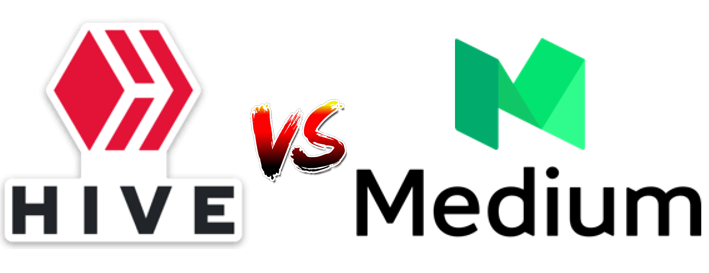Following my recent post comparing Reddit and Hive, and acknowledging Reddit's recognition as a Top 100 Most Influential company, I have decided to explore another comparison—this time between Hive and Medium.
I haven't written a blog post for many years and I am still finding my way around and figuring out what platforms and communities work best. This will be the first time I use the PEAKED front end to write my blog post.

Overview of Hive
Launch and Purpose: Introduced in 2016 as a blockchain-based social media platform.
Unique Features: Decentralization, Communities, cryptocurrency rewards (Hive, Hive Power, Hive Dollars).
Community: Focus on niche communities with a strong emphasis on content creation and curation.
Monetization: Users earn through upvotes, staking, and engagement.
Overview of Medium
Launch and Purpose: Founded in 2012 by Evan Williams, Medium serves as a platform for both amateur and professional writers.
Unique Features: Clean and simple design, high-quality content, membership model.
Community: Diverse user base including bloggers, journalists, and thought leaders.
Monetization: Partner Program, where writers earn based on member reading time and engagement.
User Experience
Content Discovery
Hive: Hive’s trending and hot categories help users find popular content, but locating specific subjects can be challenging. Communities provide some categorization, but the system is less intuitive compared to Medium.
Medium: Medium excels in content discovery with its clean layout, topic tags, and recommendations based on user interests. This makes it easier to find and follow specific subjects and writers.
Engagement
Hive: Focuses on quality content and curation. Engagement is incentivized through upvotes, which can translate into cryptocurrency rewards.
Medium: Offers a more traditional engagement model with comments, claps (likes), and follows. Engagement is often driven by the quality of content and the reputation of the writer.
User Interface
Hive: Provides a decentralized platform with various front ends like PeakD, Hive.blog, and others, allowing users to choose their preferred interface. This flexibility can enhance user experience but may also cause inconsistency.
Medium: Known for its sleek and minimalist design, Medium offers a uniform and user-friendly experience across all devices. This consistency is appealing to users who prefer a straightforward, no-frills interface.
Community and Moderation
Governance
Hive: Operates on a decentralized model where community voting plays a significant role in governance. This ensures that users have a say in platform decisions.
Medium: Uses a centralized moderation system with editorial oversight. While this can ensure content quality, it may also limit user influence over platform policies.
Community Behaviour
Hive: The incentive structure attracts users who are motivated by cryptocurrency rewards, leading to active participation in content creation. However, this can sometimes result in quantity over quality.
Medium: Attracts a mix of casual writers and professional journalists. The absence of direct monetary rewards for every user means content is often driven by passion and expertise rather than financial incentives.
Content Moderation
Hive: Content moderation is community-driven, relying on user reports and votes to manage content quality and enforce guidelines. This decentralized approach can be effective but might also lead to inconsistent enforcement.
Medium: Employs a team of editors and algorithms to maintain content standards. This centralized approach ensures consistent quality but might be seen as restrictive by some users.
Financial and Reward Systems
Hive
Reward System: Users earn Hive tokens through upvotes and engagement. This can be a significant draw for new users but also creates pressure to produce high-visibility content.
Impact on Content Quality: The reward system incentivizes active participation, though it can sometimes prioritize quantity over quality.
Medium
Reward System: Medium’s Partner Program pays writers based on member reading time and engagement. This encourages the creation of in-depth, high-quality content.
Impact on Content Quality: The focus on reader engagement and reading time often leads to well-crafted, thoughtful articles.
Growth
Hive: Still growing and evolving, Hive’s future will depend on broader market adoption of blockchain technology and cryptocurrency.
Medium: Has achieved significant growth and is widely recognized as a reputable platform for high-quality writing. Its steady growth trajectory shows potential for further expansion.
Conclusion
Both Hive and Medium offer unique advantages and cater to different audiences. Hive's decentralized nature and cryptocurrency rewards attract users interested in blockchain and earning potential, while Medium's clean design and emphasis on quality content appeal to writers and readers seeking thoughtful, engaging articles. As blockchain technology and cryptocurrency adoption continue to grow, Hive has the potential for significant expansion. Meanwhile, Medium's established reputation and consistent growth make it a reliable platform for content creators and readers alike.
Congratulations to all involved in the PEAKED development. I find this interface much easier to use and really enjoyed writing this blog post and I will most definitely use this interface again.
Happy Hiving!
My Blog Posts over the past few days:
- Hive vs. Reddit: A Comparative Analysis of Two Influential Social Platforms
- My first post in 3 Years and I have to congratulate you on a Vibrant Hive community!
- Reddit on Top 100 List of most influential Companies - 2024
- The future of Banking - Traditional Banks should adopt or die
- Revolutionizing Sponsorship: Cryptocurrency and Blockchain Companies are Partnering with Major Sports and Entertainment Ventures

Hello @jacor. Nice report comparing Hive and Medium. On Hive, I also PeakD as my front end. I love their drafts and scheduling features that are easy to use.
Thanks for sharing. Take care.
Hi @justclickindiva, sincere thanks for the comment and compliment. I will start looking at the various features that PeakD has available. If is really a much nicer experience to write on PeakD, as you do not need to struggle with Markup and the likes.